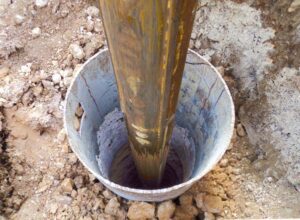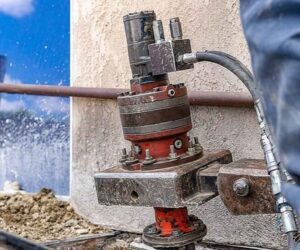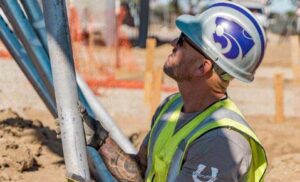When your home starts to show signs and symptoms of foundation problems, it’s an unsettling prospect as you begin to question the structural integrity of your home and the cost of repair. Or you’re trying to find the best solution to the new construction project you plan to get underway. Regardless, you’ll need some form of pile drilling or driving for your foundation.
It might come off as no secret that foundation repair and construction projects aren’t exactly cheap. Pile drilling and pile driving differ in cost and methodology. Sometimes projects require either pile drilling or driving depending on the circumstances.
Dalinghaus Construction has over 100 years of combined experience, working in various locations around Southern California, Arizona, and Nevada. We’ve done both pile drilling and driving for multiple foundation repair projects. We understand what determines whether your project needs pile drilling or pile driving.
The difference between a pile and a pier

These terms tend to be used interchangeably, but they indicate a specific purpose of use.
A pile is something freestanding or involved in a new construction type project.
A pier is something that is attached to an existing structure, whether it’s a retaining wall, a home, a commercial building, etc.
So it’s a difference between construction and repair.
The material will be the same, but the end piece will be different. For instance, a pier will have a bracket attached to it instead of a new construction cap with a pile.
Pile Drilling vs Pile Driving
Pile Drilling
This involves drilling a hole and removing soil. That way concrete, grout, or a pile can be placed for load bearing capacity of a structure.
Advantages
They vibrate less in the ground compared to some methods of pile driving.
You can also dictate how deep a hole goes, compared to pile driving might run into rocks, which are very difficult to penetrate through. Drilling allows you to dig to a required depth for capacity.
Note – you typically know how soil conditions are and you can monitor the piers as they go down a standard depth, but the outliers are conditions in the soil such as rock or a hardline layer that is required to break through.
Disadvantages
Time. It takes time and labor to excavate the holes before pouring in concrete.
Pile driving is generally more expensive. You have to consider the excavation time and the amount of time it takes for concrete to cure.
Any pile drilling you do will involve some sort of concrete or grout. There may be some sort of combination involving a pier, but there will almost always be concrete or grout to reinforce the underpinning.
Pile drilling requires larger equipment. You have to create the force to install piles via drilling, especially for excavating a large amount of dirt.
Check out our article What is Pile Driving? (Orange County Foundation Repair) for a better understanding of pile driving.
Pile Driving

This method doesn’t remove soil to make a hole. Rather, this involves displacing the soil by ramming something in such as push piers and helical piers.
Advantages
Doing this is much cheaper. Not only do you not have to worry about the cost of digging up the soil, but you also don’t need to worry about moving the soil from the location.
It’s quicker than traditional pile drilling.
On the residential side, large machines or vehicles aren’t required for pile driving. However, larger equipment is needed when driving for large shoring projects.
Note – you won’t need to worry about large equipment for your residential project. You don’t need to worry about fitting a crane in your backyard.
Disadvantages
Because this is such a broad area. Some projects have minimal issues with vibration, such as installing push piers. The same can’t be said for projects that involve shoring.
Some shoring projects hammer piles down, which can be loud, disruptive, and cause vibration. This can cause damage to other structures within the vicinity.
Those projects also involve big equipment, which can be very intrusive to your day-to-day.
For example, we’ve dealt with homes that had to endure these major projects in San Clemente – which is a haven for foundation settlement. A construction project by the freeway used pile driving and caused enough vibration for these homes to settle.
And you also have to consider the type of pier or pile you use. Push piers are very effective in foundation repair since they’re galvanized steel and don’t rely on skin friction to hold up a structure. They’re hydraulically driven down to bedrock or competent soil to carry the load of your home.
The same can’t be said for concrete piers. They’re driven into the ground, but they rely more on skin friction rather than being end-bearing. So concrete piers might not even make it past the active zone.
Look at the differences between concrete piles and push piers to understand their depths, whether they get past the active zone, and their load-bearing capacities.
Determining if your home requires pile drilling or driving

It also depends on your overall goal for the project. Some projects we’ve done have required pile drilling because rock or concrete is in the way. Stuff like that needs to be predrilled before pile installation can continue.
Cost
Again, it depends on the overall project and what you’re trying to achieve. If you were to look at the cost of installing push and helical piers compared to caissons, caissons cost about twice as much.
If you’re not sure if your home needs pile driving, have someone come out to do a free foundation evaluation.
You’ve learned about the differences between piers and piles, the advantages and disadvantages to pile driving, the advantages and disadvantages to pile drilling, and what determines if your home needs pile drilling or driving. Don’t continue to have questions about your home. Have someone come out for a FREE 60-90 minute evaluation of your foundation.
Check out our article on how long it takes to put piers in a foundation.
You also want to check out our versus article on concrete underpinning vs push and helical pier underpinning.
For additional questions or to schedule an evaluation, call Dalinghaus Construction at (877)360-9277.






